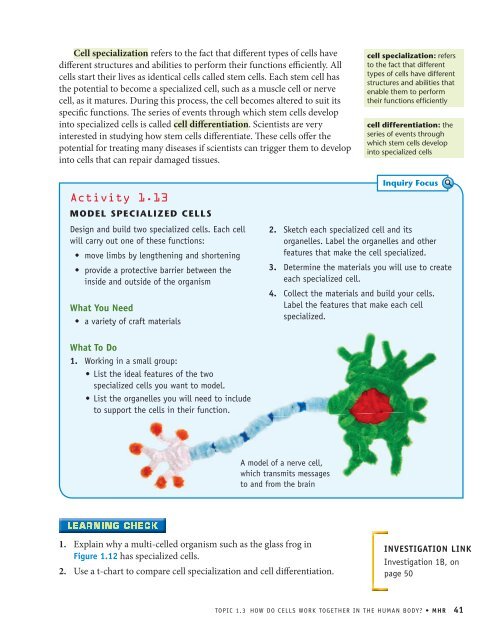How do cells work together in the human body? - McGraw-Hill ...
How do cells work together in the human body? - McGraw-Hill ...
How do cells work together in the human body? - McGraw-Hill ...
Create successful ePaper yourself
Turn your PDF publications into a flip-book with our unique Google optimized e-Paper software.
Cell specialization refers to <strong>the</strong> fact that different types of <strong>cells</strong> have<br />
different structures and abilities to perform <strong>the</strong>ir functions efficiently. All<br />
<strong>cells</strong> start <strong>the</strong>ir lives as identical <strong>cells</strong> called stem <strong>cells</strong>. Each stem cell has<br />
<strong>the</strong> potential to become a specialized cell, such as a muscle cell or nerve<br />
cell, as it matures. Dur<strong>in</strong>g this process, <strong>the</strong> cell becomes altered to suit its<br />
specific functions. The series of events through which stem <strong>cells</strong> develop<br />
<strong>in</strong>to specialized <strong>cells</strong> is called cell differentiation. Scientists are very<br />
<strong>in</strong>terested <strong>in</strong> study<strong>in</strong>g how stem <strong>cells</strong> differentiate. These <strong>cells</strong> offer <strong>the</strong><br />
potential for treat<strong>in</strong>g many diseases if scientists can trigger <strong>the</strong>m to develop<br />
<strong>in</strong>to <strong>cells</strong> that can repair damaged tissues.<br />
cell specialization: refers<br />
to <strong>the</strong> fact that different<br />
types of <strong>cells</strong> have different<br />
structures and abilities that<br />
enable <strong>the</strong>m to perform<br />
<strong>the</strong>ir functions efficiently<br />
cell differentiation: <strong>the</strong><br />
series of events through<br />
which stem <strong>cells</strong> develop<br />
<strong>in</strong>to specialized <strong>cells</strong><br />
Activity 1.13<br />
MODEL SPECIALIZED CELLS<br />
Design and build two specialized <strong>cells</strong>. Each cell<br />
will carry out one of <strong>the</strong>se functions:<br />
• move limbs by leng<strong>the</strong>n<strong>in</strong>g and shorten<strong>in</strong>g<br />
• provide a protective barrier between <strong>the</strong><br />
<strong>in</strong>side and outside of <strong>the</strong> organism<br />
What You Need<br />
• a variety of craft materials<br />
Inquiry Focus<br />
2. Sketch each specialized cell and its<br />
organelles. Label <strong>the</strong> organelles and o<strong>the</strong>r<br />
features that make <strong>the</strong> cell specialized.<br />
3. Determ<strong>in</strong>e <strong>the</strong> materials you will use to create<br />
each specialized cell.<br />
4. Collect <strong>the</strong> materials and build your <strong>cells</strong>.<br />
Label <strong>the</strong> features that make each cell<br />
specialized.<br />
What To Do<br />
1. Work<strong>in</strong>g <strong>in</strong> a small group:<br />
• List <strong>the</strong> ideal features of <strong>the</strong> two<br />
specialized <strong>cells</strong> you want to model.<br />
• List <strong>the</strong> organelles you will need to <strong>in</strong>clude<br />
to support <strong>the</strong> <strong>cells</strong> <strong>in</strong> <strong>the</strong>ir function.<br />
A model of a nerve cell,<br />
which transmits messages<br />
to and from <strong>the</strong> bra<strong>in</strong><br />
1. Expla<strong>in</strong> why a multi-celled organism such as <strong>the</strong> glass frog <strong>in</strong><br />
Figure 1.12 has specialized <strong>cells</strong>.<br />
2. Use a t-chart to compare cell specialization and cell differentiation.<br />
INVESTIGATION LINK<br />
Investigation 1B, on<br />
page 50<br />
TOPIC 1.3 HOW DO CELLS WORK TOGETHER IN THE HUMAN BODY? • MHR 41

















